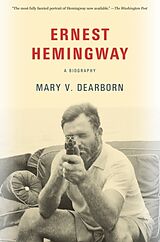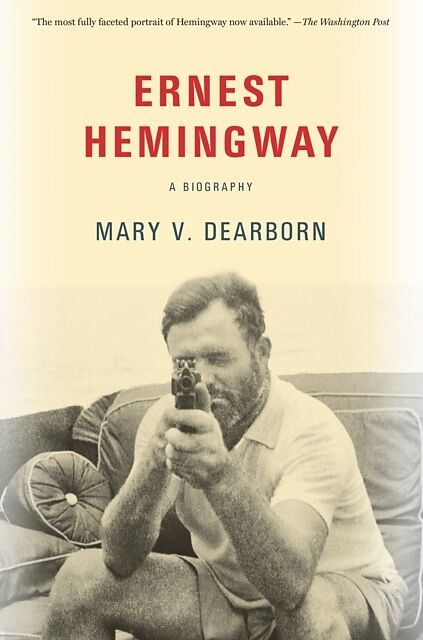Ernest Hemingway
Einband:
Broschiert
EAN:
9780525563617
Untertitel:
A Biography
Genre:
Briefe & Biografien
Autor:
Mary Dearborn
Herausgeber:
Random House N.Y.
Anzahl Seiten:
752
Erscheinungsdatum:
11.09.2018
ISBN:
052556361X
A St. Louis Post Dispatch Best Book of 2017 The first full biography of Ernest Hemingway in more than fifteen years is the first to draw on a wide array of never-before-used material, resulting in the most nuanced portrait to date of this complex, enigmatic artist. Considered in his time the greatest living American writer, Hemingway was a winner of the Pulitzer Prize and the Nobel Prize whose personal demons undid him in the end, and whose novels and stories have influenced the writing of fiction for generations after his death. Mary V. Dearborn’s revelatory investigation of his life and work substantially deepens our understanding of the artist and the man.
Acclaim for Mary V. Dearborn’s ERNEST HEMINGWAY
“The most fully faceted portrait of Hemingway now available.” —The Washington Post
“A fresh perspective. . . . Keenly dispassionate, coolly discerning. . . . A kind of extended autopsy, not only of Hemingway’s life, but his reputations as a model of American virility and as an enduring literary figure.” —USA Today
“Perceptive and tough-minded. . . . Dearborn skillfully covers an enormous range of rich material.” —The New York Times Book Review
“Fresh. . . . Impeccably researched. . . . Hemingway fans will find something interesting on almost every page.” —Houston Chronicle
“A compelling portrait. . . . Dearborn captures Hemingway in all of his extremes, the story of a hugely flawed and endlessly compelling human being producing enduring art.” —Star Tribune
Autorentext
MARY V. DEARBORN received a doctorate in English and Comparative Literature from Columbia University, where she was a Mellon Fellow in the Humanities. She is the author of Mistress of Modernsim, Mailer, Queen of Bohemia, The Happiest Man Alive, Love in the Promised Land, and Pocahontas's Daughters. She lives in Massachusetts.
Klappentext
A St. Louis Post Dispatch Best Book of 2017
The first full biography of Ernest Hemingway in more than fifteen years is the first to draw on a wide array of never-before-used material, resulting in the most nuanced portrait to date of this complex, enigmatic artist. Considered in his time the greatest living American writer, Hemingway was a winner of the Pulitzer Prize and the Nobel Prize whose personal demons undid him in the end, and whose novels and stories have influenced the writing of fiction for generations after his death. Mary V. Dearborn's revelatory investigation of his life and work substantially deepens our understanding of the artist and the man.
Zusammenfassung
Incorporating fascinating new research, Mary Dearborn’s revelatory investigation of Hemingway’s life and work substantially deepens our understanding of the artist and the man.
A St. Louis Post Dispatch Best Book of the Year
The “most fully faceted portrait of Hemingway now available” (The Washington Post) draws on a wide array of never-before-used material, resulting in the most nuanced biography to date of this complex, enigmatic artist.
Considered in his time the greatest living American writer, Hemingway was a winner of the Pulitzer Prize and the Nobel Prize whose personal demons undid him in the end, and whose novels and stories have influenced the writing of fiction for generations after his death.
Leseprobe
Prologue
One evening in the mid-1990s I attended a panel on Ernest Hemingway and his work at New York’s Mercantile Library. The Mercantile was known for lively programming arranged by its then director, Harold Augenbraum, and this evening was no exception. Hemingway had been somewhat under fire of late. A controversial 1987 biography by Kenneth Lynn had left Hemingway fans reeling with the revelation that Ernest had been dressed as a girl in his early years, which Lynn argued had shaped the author’s psyche and sexuality.
The previous year Hemingway’s posthumously published novel, The Garden of Eden, had revealed a writer seemingly obsessed with androgyny, its hero and heroine cutting and dyeing their hair to become identical, beyond gender—just as in the explicit sex scenes they move beyond traditionally male and female roles. At roughly the same time, Hemingway and his place in the Western literary tradition came under full-on attack, as readers, scholars, educators, and activists urgently questioned what “dead white males” like Hemingway had to say to us in a multicultural era that no longer accords them automatic priority. The so-called Hemingway code—a tough, stoic approach to life that seemingly substitutes physical courage and ideals of strength and skill for other forms of accomplishment—increasingly looked insular and tiresomely macho.
That night at the Mercantile Library, these issues were roiling the waters. Should we still read Hemingway? Are his concerns still relevant? Was Hemingway gay? (The short answer is no.) Why could he not create a complicated female heroine? Does Hemingway have anything at all to say to people of different races and ethnicities? On the plus side, does his intense feeling for the natural world take on greater significance at a time of growing environmental consciousness? If we were to continue to read Hemingway, we needed to take note of how we read him, it seemed.
The discussion after the panel was animated. The moderator called on a burly man with a peppery crew cut. I recognized him as a professor and critic who wrote about the literature of the 1920s, especially Hemingway’s friend F. Scott Fitzgerald. “I just want to say one thing,” he stood up and announced. “Hemingway made it possible for me to do what I do.”
I thought about what he said for a long time afterward. He seemed to mean something very specific and personal—something to do with reading literature and writing about it as a vocation. He was not talking about teaching or making money. He was talking about whether writing was an acceptable occupation for a man, both on his terms and the world’s. Hemingway, not only in his extraliterary pursuits as a marlin fisherman, a big game hunter, a boxer, and a bullfight aficionado but also in his capacity as an icon of American popular culture, was the very personification of virility—and he was a writer. Any taint of femininity or aestheticism attached to writing had been wiped clean.
I was reminded of a rather extraordinary statement made late in life by the writer Harold Loeb, the model for Robert Cohn in Hemingway’s first full-length novel, The Sun Also Rises—the lover of Lady Brett Ashley who proves himself a wet blanket during the Pamplona bullfighting fiesta. It was hardly a flattering portrayal, but Loeb had not forgotten why he, like so many others, had been drawn to Hemingway when they both were young: “I admired his combination of toughness and sensitiveness. . . . I had long suspected that one reason for the scarcity of good writers in the United States was the popular impression—that artists were not quite virile. It was a good sign that men like Hemingway were taking up writing.”
As I went on to think and write about Hemingway myself in the period following this panel, I thought I understood the critic’s remarks that evening. But I couldn’t account for the risky, emotional, and highly personal nature of his confession. What I couldn’t understand was his passion. It seemed to me that something was being said here about being a man and a writ…

Leider konnten wir für diesen Artikel keine Preise ermitteln ...
billigbuch.ch sucht jetzt für Sie die besten Angebote ...
Die aktuellen Verkaufspreise von 6 Onlineshops werden in Realtime abgefragt.
Sie können das gewünschte Produkt anschliessend direkt beim Anbieter Ihrer Wahl bestellen.
Loading...
Die aktuellen Verkaufspreise von 6 Onlineshops werden in Realtime abgefragt.
Sie können das gewünschte Produkt anschliessend direkt beim Anbieter Ihrer Wahl bestellen.
| # | Onlineshop | Preis CHF | Versand CHF | Total CHF | ||
|---|---|---|---|---|---|---|
| 1 | Seller | 0.00 | 0.00 | 0.00 |
